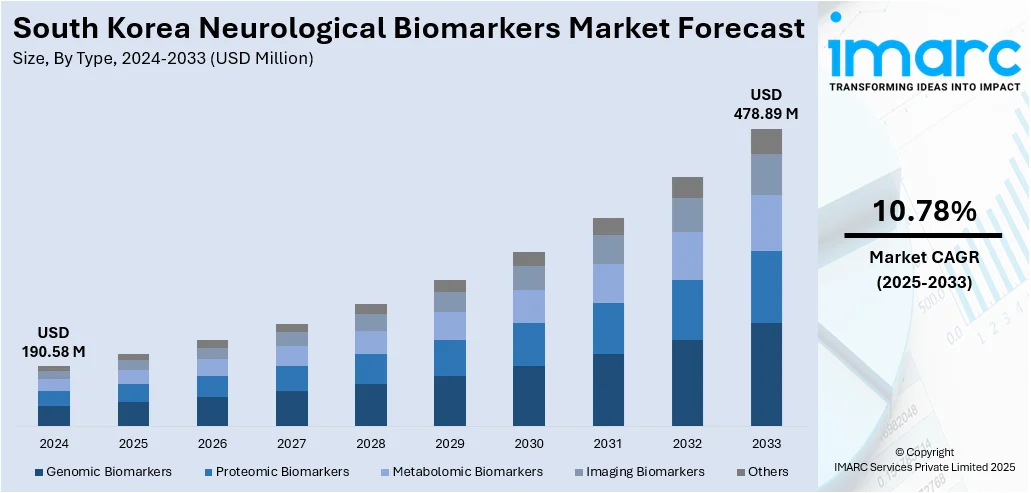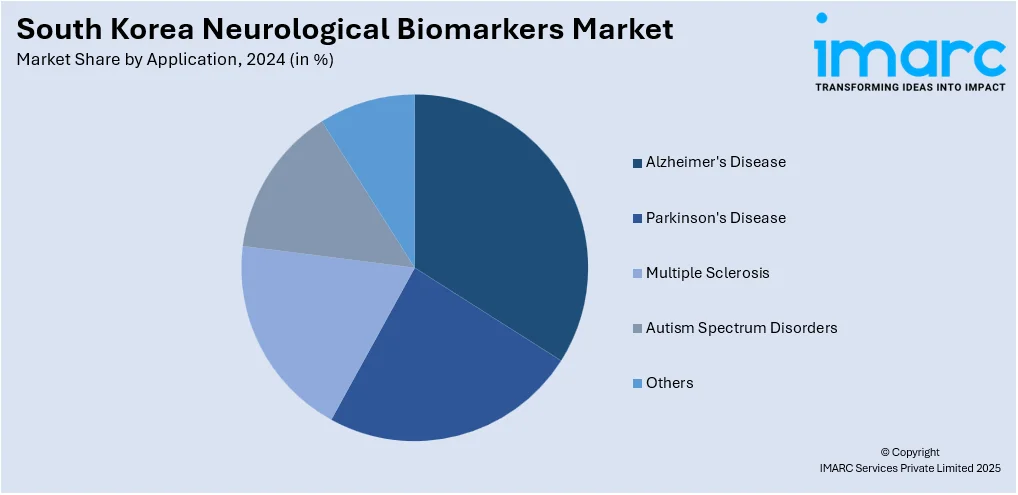
South Korea Neurological Biomarkers Market Size, Share, Trends and Forecast by Type, Application, End Use, and Region, 2025-2033
South Korea Neurological Biomarkers Market Overview:
The South Korea neurological biomarkers market size reached USD 190.58 Million in 2024. Looking forward, the market is expected to reach USD 478.89 Million by 2033, exhibiting a growth rate (CAGR) of 10.78% during 2025-2033. The market is witnessing steady growth due to the rising prevalence of neurological disorders, advancements in diagnostic technologies, and increasing research in personalized medicine. Expanding healthcare infrastructure and growing awareness about early disease detection are further contributing to the expansion of the South Korea neurological biomarkers market share.
|
Report Attribute
|
Key Statistics
|
|---|---|
|
Base Year
|
2024 |
|
Forecast Years
|
2025-2033
|
|
Historical Years
|
2019-2024
|
| Market Size in 2024 | USD 190.58 Million |
| Market Forecast in 2033 | USD 478.89 Million |
| Market Growth Rate 2025-2033 | 10.78% |
South Korea Neurological Biomarkers Market Trends:
Rising Prevalence of Neurological Disorders and Aging Population
The aging population in South Korea is contributing to a prevalent increase in neurological diseases like Alzheimer's, Parkinson's, and other mental disorders. With an increase in the size of the elderly population, there is increased desperation for early identification and adequate surveillance of the neurodegenerative diseases. Biomarkers in neurology are a significant contribution to discovering conditions in time to conduct specific interventions. As people have become more knowledgeable about the pivotal role of preventative medicine, the need to have high-end diagnostic equipment has become imminent. The government healthcare policies are also coming in line with academic research and are working on establishing a preference in neurological health, which will only increase the demand. This demographic-driven rise in neurological conditions has become a core factor propelling the South Korea neurological biomarkers market growth.

To get more information on this market, Request Sample
Advancement in Omics Technologies and AI-Based Diagnostics
The integration of advanced technologies such as genomics, proteomics, and metabolomics is significantly enhancing biomarker discovery in South Korea. These omics-based tools, when combined with artificial intelligence and machine learning, enable precise molecular profiling and early diagnosis of neurological diseases. AI algorithms improve diagnostic accuracy by analyzing complex datasets, identifying biomarker patterns, and predicting disease progression. This tech-driven transformation is also fostering the development of personalized treatment plans tailored to individual patient profiles. Increased investment in precision medicine by both government bodies and private firms is driving innovation across diagnostic platforms. As South Korea leads in digital health adoption, the synergy of omics and AI technologies is playing a pivotal role in accelerating market expansion for neurological biomarkers.
Growing Focus on Non-Invasive Diagnostics and R&D Investment
There is a growing preference in South Korea for non-invasive diagnostic methods in neurology, especially blood-based and imaging biomarkers, which offer greater convenience and patient compliance compared to traditional approaches like biopsies or spinal taps. These tools facilitate earlier diagnosis and improve monitoring throughout the treatment process. Simultaneously, significant public and private sector investments in research and development (R&D) are accelerating innovation in biomarker development. Academic institutions, biotech firms, and government agencies are collaborating to support clinical trials, enhance biomarker validation, and promote commercialization. This combined focus on innovation and patient-centered diagnostics is opening new opportunities across hospitals, research labs, and diagnostic centers, positioning non-invasive biomarkers as a cornerstone of the country’s evolving neurological healthcare landscape.
South Korea Neurological Biomarkers Market Segmentation:
IMARC Group provides an analysis of the key trends in each segment of the market, along with forecasts at the country and regional levels for 2025-2033. Our report has categorized the market based on type, application, and end use.
Type Insights:
- Genomic Biomarkers
- Proteomic Biomarkers
- Metabolomic Biomarkers
- Imaging Biomarkers
- Others
The report has provided a detailed breakup and analysis of the market based on the type. This includes genomic biomarkers, proteomic biomarkers, metabolomic biomarkers, imaging biomarkers, and others.
Application Insights:

- Alzheimer's Disease
- Parkinson's Disease
- Multiple Sclerosis
- Autism Spectrum Disorders
- Others
A detailed breakup and analysis of the market based on the application have also been provided in the report. This includes Alzheimer's disease, Parkinson's disease, multiple sclerosis, autism spectrum disorders, and others.
End Use Insights:
- Hospital Laboratories
- Clinical Diagnostic Centers
- Research Organizations
- Others
The report has provided a detailed breakup and analysis of the market based on the end use. This includes hospital laboratories, clinical diagnostic centers, research organizations, and others.
Regional Insights:
- Seoul Capital Area
- Yeongnam (Southeastern Region)
- Honam (Southwestern Region)
- Hoseo (Central Region)
- Others
The report has also provided a comprehensive analysis of all the major regional markets, which include Seoul Capital Area, Yeongnam (Southeastern Region), Honam (Southwestern Region), Hoseo (Central Region), and others.
Competitive Landscape:
The market research report has also provided a comprehensive analysis of the competitive landscape. Competitive analysis such as market structure, key player positioning, top winning strategies, competitive dashboard, and company evaluation quadrant has been covered in the report. Also, detailed profiles of all major companies have been provided.
South Korea Neurological Biomarkers Market News:
- In February 2025, Global Clinical Central Lab (GCCL) launched Korea’s first commercial biomarker analysis service for Parkinson’s disease, expanding diagnostic capabilities for neurodegenerative disorders. The company announced that it has successfully developed and commercialized an analytical method for detecting alpha-synuclein (αSyn), a key biomarker for Parkinson’s and related conditions.
- In January 2025, LVIS Corp, which stands for "Live Visualization of Brain Circuits," introduced Neuromatch Access, a cloud-based platform offered as software-as-a-service (SaaS). Designed to assist neurologists and healthcare professionals, the platform enables efficient review, interpretation, and analysis of electroencephalogram (EEG) data.
South Korea Neurological Biomarkers Market Report Coverage:
| Report Features | Details |
|---|---|
| Base Year of the Analysis | 2024 |
| Historical Period | 2019-2024 |
| Forecast Period | 2025-2033 |
| Units | Million USD |
| Scope of the Report | Exploration of Historical Trends and Market Outlook, Industry Catalysts and Challenges, Segment-Wise Historical and Future Market Assessment:
|
| Types Covered | Genomic Biomarkers, Proteomic Biomarkers, Metabolomic Biomarkers, Imaging Biomarkers, Others |
| Applications Covered | Alzheimer's Disease, Parkinson's Disease, Multiple Sclerosis, Autism Spectrum Disorders, Others |
| End Uses Covered | Hospital Laboratories, Clinical Diagnostic Centers, Research Organizations, Others |
| Regions Covered | Seoul Capital Area, Yeongnam (Southeastern Region), Honam (Southwestern Region), Hoseo (Central Region), Others |
| Customization Scope | 10% Free Customization |
| Post-Sale Analyst Support | 10-12 Weeks |
| Delivery Format | PDF and Excel through Email (We can also provide the editable version of the report in PPT/Word format on special request) |
Key Questions Answered in This Report:
- How has the South Korea neurological biomarkers market performed so far and how will it perform in the coming years?
- What is the breakup of the South Korea neurological biomarkers market on the basis of type?
- What is the breakup of the South Korea neurological biomarkers market on the basis of application?
- What is the breakup of the South Korea neurological biomarkers market on the basis of end use?
- What is the breakup of the South Korea neurological biomarkers market on the basis of region?
- What are the various stages in the value chain of the South Korea neurological biomarkers market?
- What are the key driving factors and challenges in the South Korea neurological biomarkers market?
- What is the structure of the South Korea neurological biomarkers market and who are the key players?
- What is the degree of competition in the South Korea neurological biomarkers market?
Key Benefits for Stakeholders:
- IMARC’s industry report offers a comprehensive quantitative analysis of various market segments, historical and current market trends, market forecasts, and dynamics of the South Korea neurological biomarkers market from 2019-2033.
- The research report provides the latest information on the market drivers, challenges, and opportunities in the South Korea neurological biomarkers market.
- Porter's five forces analysis assist stakeholders in assessing the impact of new entrants, competitive rivalry, supplier power, buyer power, and the threat of substitution. It helps stakeholders to analyze the level of competition within the South Korea neurological biomarkers industry and its attractiveness.
- Competitive landscape allows stakeholders to understand their competitive environment and provides an insight into the current positions of key players in the market.
Need more help?
- Speak to our experienced analysts for insights on the current market scenarios.
- Include additional segments and countries to customize the report as per your requirement.
- Gain an unparalleled competitive advantage in your domain by understanding how to utilize the report and positively impacting your operations and revenue.
- For further assistance, please connect with our analysts.
 Request Customization
Request Customization
 Speak to an Analyst
Speak to an Analyst
 Request Brochure
Request Brochure
 Inquire Before Buying
Inquire Before Buying




.webp)




.webp)












